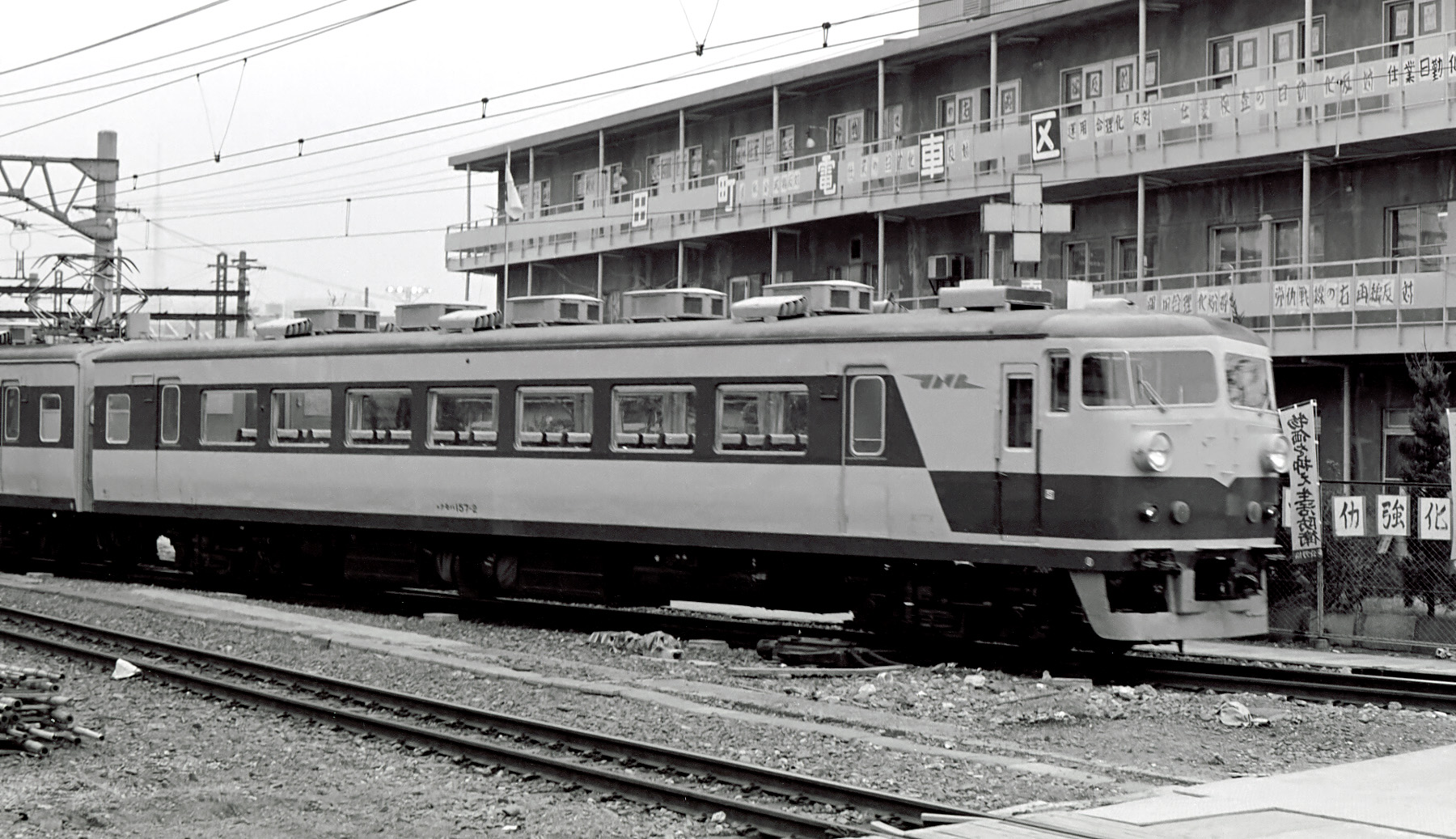157 Series on:
[Wikipedia]
[Google]
[Amazon]
The was a Japanese DC
File:157 Hibiki Yokohama.jpg, A 157 series set on a ''Hibiki'' limited express service in the 1970s
File:157 Shirane Ueno Station 19740811.jpg, A 157 series set on a ''Shirane'' limited express service from Ueno, August 1974
File:157series03tsc.jpg, The dedicated imperial train car KuRo 157-1, June 1977
File:183royal.JPG, The imperial train car KuRo 157-1 sandwiched in a 183 series set, August 1980

electric multiple unit
An electric multiple unit or EMU is a multiple-unit train consisting of self-propelled carriages using electricity as the motive power. An EMU requires no separate locomotive, as electric traction motors are incorporated within one or a number o ...
(EMU) train type operated on limited express
A limited express is a type of express train or express bus service that stops at fewer locations compared to other express services on the same or similar routes.
Japan
The term "limited express" is a common translation of the Japanese ...
services by Japanese National Railways
The , abbreviated JNR or , was the business entity that operated Japan's national railway network from 1949 to 1987.
Network Railways
As of June 1, 1949, the date of establishment of JNR, it operated of narrow gauge () railways in all 46 pre ...
(JNR) from 1959 until 1980.
Operations
The 157 series EMUs were first introduced by JNR on ''Nikkō
is a Cities of Japan, city in Tochigi Prefecture, Japan. , the city's population was 80,239, in 36,531 households. The population density was 55 persons per km2. The total area of the city is .
Nikkō is a popular destination for Japanese and ...
'' semi express services between and on 22 September 1959 to counter competition from the private company Tobu Railway
is a Japanese commuter railway and ''keiretsu'' holding company in the Greater Tokyo Area as well as an intercity and regional operator in the Kantō region. Excluding the Japan Railways Group companies, Tobu's rail system is the second longes ...
, which also operated trains to Nikkō. They were also used on ''Chusenji'' services between and Nikkō, and ''Nasuno
The is a train service operated on the Tōhoku Shinkansen by East Japan Railway Company (JR East) in Japan. It serves all stations between and , a medium-sized city approximately 225 km north of Tokyo.JR Timetable, December 2008
Origin
...
'' services between and .
157 series EMUs were also introduced on seasonal ''Hibiki'' services on the Tokaido Main Line from 21 November 1959, and were later used on ''Amagi'' and '' Soyokaze'' services.
Fleet details
* KuMoHa 157-1 – 10: Driving motor cars * MoHa 156-1 – 10: Intermediate motor cars, with one pantograph * SaHa 157-1 – 5: Intermediate trailer cars * SaRo 157-1 – 6: Intermediate "Green" (first class) trailer cars * KuRo 157-1: Imperial train car (see below)External livery
Initially painted in the JNR livery of beige ("Cream No. 4") and crimson ("Red No. 11"), the red colour was later changed to a slightly darker shade ("Red No. 2") when the sets were modified with the addition of air-conditioning.KuRo 157-1 imperial train car
The 157 series fleet included a dedicated imperial train car, built by Kawasaki Sharyo (present-dayKawasaki Heavy Industries
is a Japanese Public company, public multinational corporation manufacturer of motorcycles, engines, Heavy equipment (construction), heavy equipment, aerospace and Military, defense equipment, rolling stock and ships, headquartered in Minato, To ...
) and delivered in June 1960. Numbered KuRo 157-1, the car could be inserted into 157 series formations for use on imperial train workings. One end had a gangwayed driving cab based on the 153 series
The was an electric multiple unit (EMU) train type operated by Japanese National Railways (JNR) from 1958 until 1983.
Interior
File:Inside of JNR Class 153 (without air-condition).jpg, Interior of a non-air-conditioned 153 series car
Histo ...
EMU design, although the car was normally sandwiched in the middle of a 157 series formation, and was only very rarely used with the driving cab leading. In 1979, the car was modified for use in conjunction with 183 series
The was a Japanese limited express electric multiple unit (EMU) train type introduced in 1972 by Japanese National Railways (JNR). Following the privatization of JNR, the 183 series was operated by East Japan Railway Company (JR East) and We ...
EMUs, with the first official working on 2 July 1980. From March 1985, it was repainted in cream with a green stripe for use in conjunction with 185 series
The 185 series () is an electric multiple unit (EMU) train type operated by the East Japan Railway Company (JR East) primarily on mid-distance limited express services centering on Tokyo. As of August of 2024, two sets operate as Special Limit ...
EMUs.
The last official operation of the car was on 8 September 1993.
Following retirement, the KuRo 157-1 car remained in storage at Tamachi Depot for many years, but was moved to Tokyo General Rolling Stock Centre in the early hours of 2 December 2012.
History
The first 157 series set was delivered in August 1959, and entered service on ''Nikkō
is a Cities of Japan, city in Tochigi Prefecture, Japan. , the city's population was 80,239, in 36,531 households. The population density was 55 persons per km2. The total area of the city is .
Nikkō is a popular destination for Japanese and ...
'' semi express services between Tokyo and Nikkō from 22 September 1959. Air-conditioning was added to the trains from 1962.
With the exception of the special imperial train car KuRo 157-1, the entire fleet of 157 series trains was withdrawn by 1980.
Fleet details
The individual car histories are as follows.References
{{JR East EMU Electric multiple units of Japan East Japan Railway Company Train-related introductions in 1959 1959 in rail transport 1500 V DC multiple units of Japan Kawasaki multiple units Kisha Seizo multiple units Nippon Sharyo multiple units